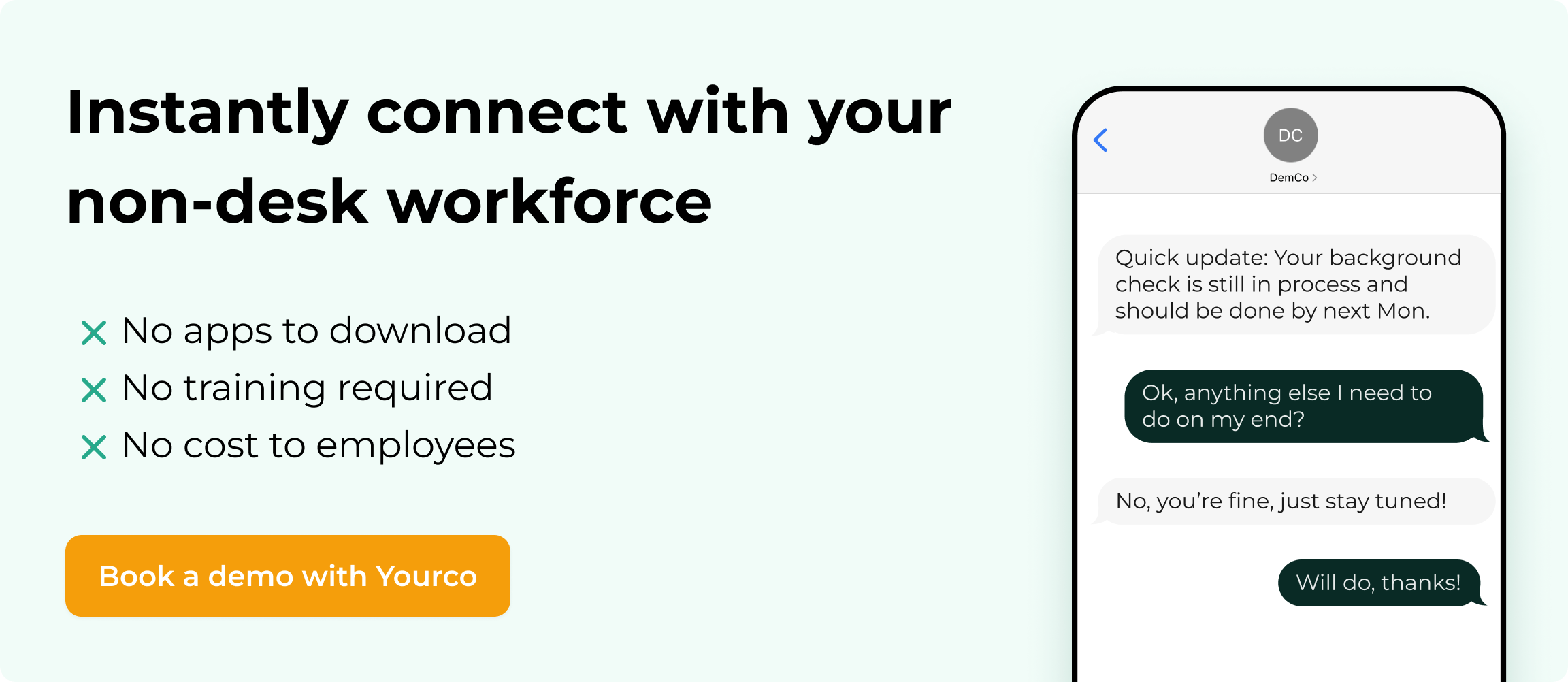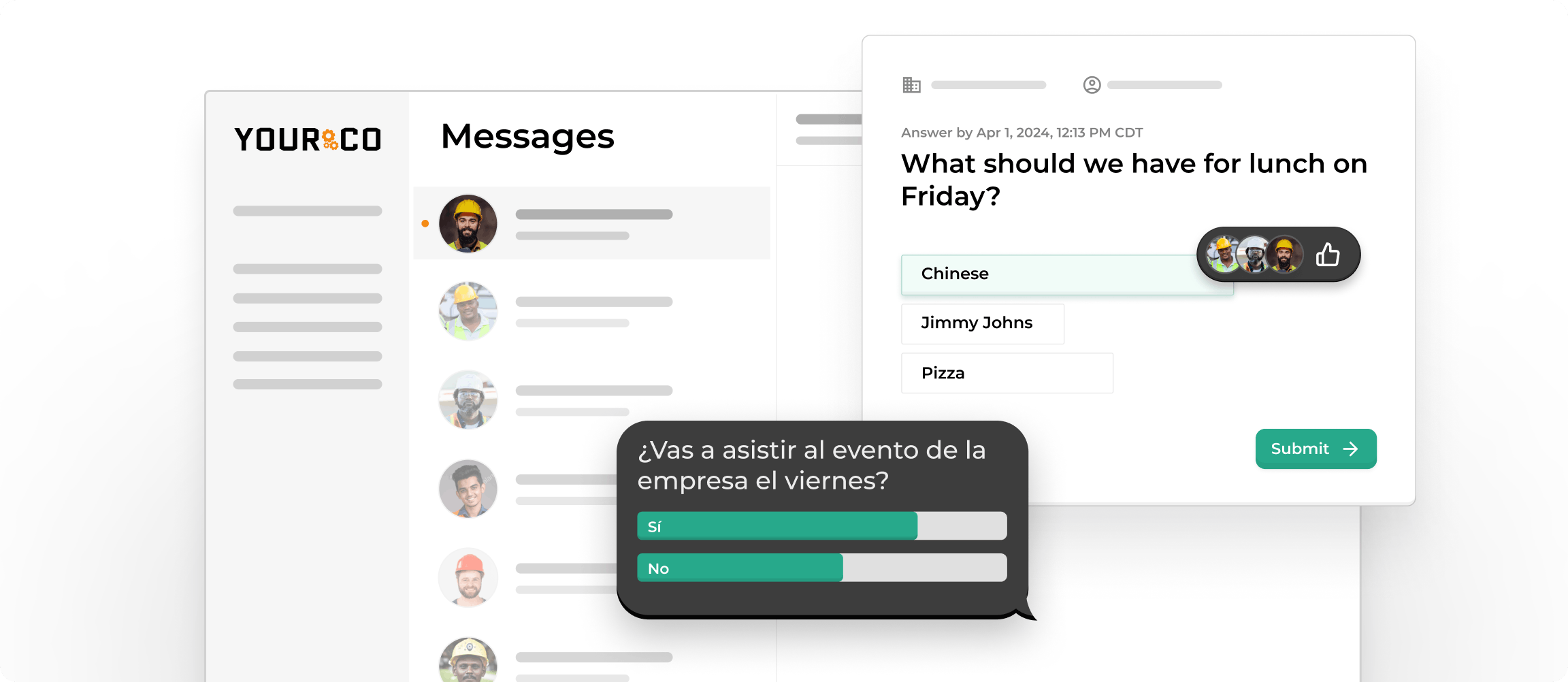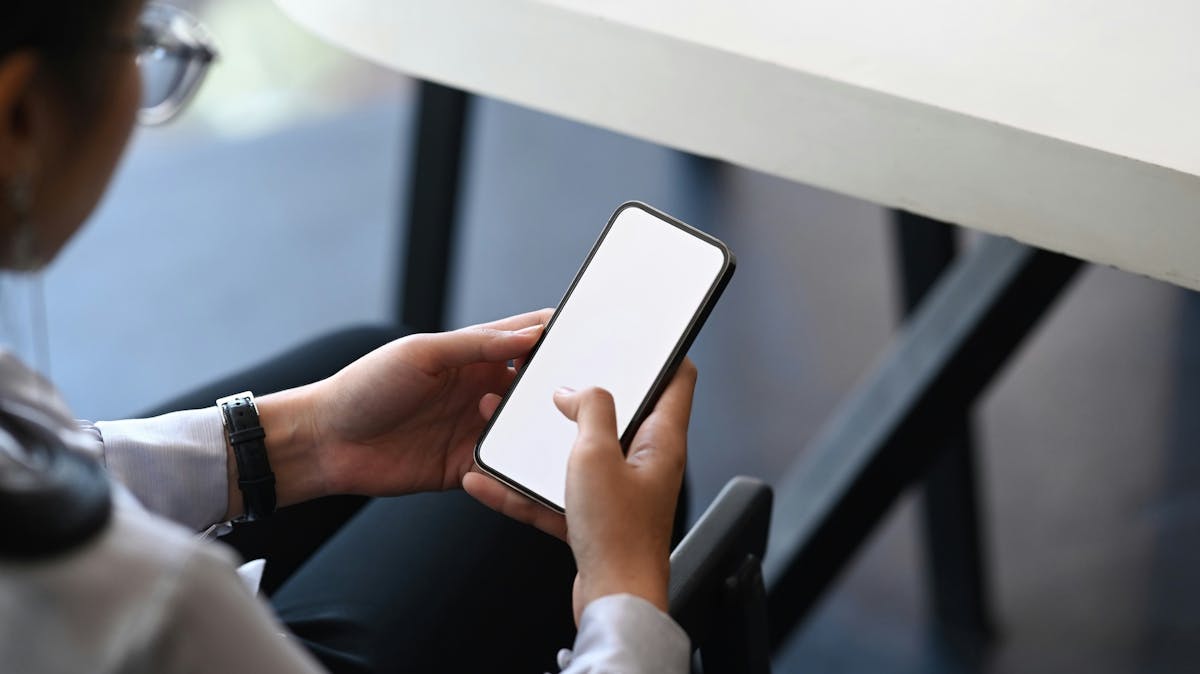Avoid the #1 Open Enrollment Mistake: Reach Deskless Staff


Open enrollment shouldn't feel like a communication nightmare, but for many HR teams, it does. Every year, the same problems surface: employees missing deadlines, flooding help desks with last-minute questions, and scrambling to understand their benefits options.
The root cause often traces back to one critical mistake: failing to reach your deskless workforce effectively. Most employees don't sit behind computers all day, yet many organizations still rely primarily on email to communicate vital enrollment information.
This guide walks you through a complete 60-day strategy that reaches every employee, from office workers to night-shift teams. You'll get step-by-step instructions, with ready-to-send message templates. By the end, you'll have everything needed to launch your first company-wide enrollment campaign within 24 hours.
Identify the Deskless Communication Gap and Its Cost
Most of your workforce isn't checking email. Eight out of ten workers globally spend their days on shop floors, delivery routes, or hospital wings, not behind a computer screen. When you send open-enrollment updates through email, you're missing the majority of your team.
The numbers tell the story: text messages get a 98% open rate while work emails average just 20%. That enrollment reminder sitting in Outlook? It might as well not exist for a warehouse worker who checks email once a week.
When your messages don't reach employees, the same problems show up every year. Poor communication consistently ranks as the top open enrollment mistake, and you feel it immediately when HR phone lines get jammed with "How do I sign up?" calls. Instead of focusing on strategic work, your team gets stuck answering the same questions over and over.
The consequences go beyond frustration. Workers who miss deadlines because they never got clear instructions can end up without coverage, creating last-minute exceptions and manual paperwork. Your team scrambles to fix elections, issue temporary ID cards, and handle frustrated follow-ups, all because the original message sat unread in a cluttered inbox.
When you reach employees on the device they use every day, everything changes:
- Important dates arrive in their pocket
- Deadlines get met the first time
- Your HR team gets back the hours lost to preventable confusion
Learning how to bridge communication gaps with your deskless workforce becomes essential for enrollment success.
Audit Your Data and Set Goals Before You Hit Send
The smoother your prep, the fewer panicked messages you'll field once enrollment opens. Start eight to twelve weeks out — that breathing room lets you find last year's blind spots, set clear targets, and clean your contact data before a single text goes out. Early preparation also gives employees time to absorb changes instead of rushing decisions.
Begin with a simple three-step checklist:
- Look back at previous years: Pull reports, help-desk tickets, and informal feedback. Did employees miss deadlines? Were certain plans misunderstood? Use those findings to shape this year's focus.
- Set clear goals: Hard goals might be "100% confirmation receipts by day five" while soft goals could target a 20-point bump in the post-enrollment "benefits understanding" survey.
- Prep your data: Verify mobile numbers, preferred languages, union status, work location, and shift schedules.
Strong data unlocks smart segmentation. A forklift driver on nights needs a different cadence than a corporate analyst. Segmenting by location, job type, and language makes each message feel personal, not like generic communications that often get ignored.
It also helps you schedule messages for when people are awake and available to respond, thereby increasing engagement.
Once your audit, goals, and data are aligned, create a master calendar marking every send date, stakeholder review, and file-upload window. With the groundwork laid, launch day turns into a routine push.
Build Your SMS-Driven Plan
A clear, scheduled cadence keeps enrollment on track and prevents last-minute crises. Start your campaign:
- Sixty days before enrollment opens: First announcement including enrollment dates, a link to a short FAQ, and an invitation for early questions.
- Thirty days out: Shift from dates to value by highlighting one benefit that often confuses people, like the high-deductible plan option, then include a link to a clear explanation document if available.
- Fourteen days before enrollment ends: Bring decisions to the surface with a quick reminder about PTO carryover or 401(k) changes so employees can gather what they need before the deadline hits.
- One week out: Add urgency with a multilingual "one week left" alert, including a direct enrollment link to keep night-shift and weekend crews informed.
- The day before enrollment closes: Send the final alert and request confirmation with a simple reply like "Reply DONE once you've enrolled" to track completion in real-time.
- Closing day: Thank everyone, explain what happens next, and include a brief three-question survey link to improve next year's process.
Here are sample messages that stay under 160 characters, but review and adjust deadline dates as needed for your specific plan:
- 60-Day: Open Enrollment starts 11/1. Save the date & check FAQs: [insert link]
- 30-Day: New HDHP saves avg $42/week. See if it fits: [insert link]
- 14-Day: Pick PTO rollover & 401k changes before 10/25. Details: [insert link]
- 7-Day: One week left! Enroll before 10/31 here: [insert link]
- 1-Day: Last call — enroll by midnight. Reply DONE when finished.
- Close: Thanks for enrolling! Tell us how we did: [insert survey link]
Write like you're helping a coworker by using clear action words, plain English, one link per message, and skipping the jargon.
Break complex information into short videos or simple PDFs that your texts can reference. Pull first names, preferred languages, and locations from your HRIS so texts feel relevant rather than generic.
Layer Supporting Channels for Maximum Reach
While texts grab attention, other channels reinforce the message. Pair each SMS with matching posters in break rooms, brief mentions during shift meetings, and portal reminders for desk workers.
Physical signs help when phones stay in lockers during work hours, quick in-person reminders let supervisors answer immediate questions, and portal prompts reach office staff who work online all day.
These supporting channels work around SMS without competing with it — texts remain the primary alert system while other touchpoints add depth to your campaign.
Master Content and Cadence Best Practices
Text messages only work when they land clearly and quickly. Every message you send should follow the 3C framework: Clear, Concise, Conversational. This means using plain-English sentences, avoiding jargon, and including just one action employees can complete right from their phone.
Translate benefits jargon into everyday terms that make sense to your team. Say "paycheck cost" instead of "employee contribution," or "pick a doctor" instead of "select an in-network primary care physician." When you need more space than a text allows, point people to quick resources that work well on phones: a two-minute video, a one-page summary, or a simple mobile form.
Keep the conversation two-way with quick interactions. A quick survey link gives you instant feedback and cuts down on repeat questions. Teams using this approach report faster responses and fewer support calls.
Timing matters just as much as content. Stick to no more than two texts per week until the final countdown, then add reminders at 7 days, 1 day, and final hour. Schedule around real work shifts since night crews won't see a 9 a.m. message. Send their alerts just before their shift starts instead. When you segment by schedule or location, every worker gets the message while they're awake and available to act on it.
Track Results and Optimize Your Approach
The moment your first text goes out, you need to know how well your strategy is working. SMS gives you real-time insight that email never can, but only if you track the right numbers.
Start by watching these essential metrics for every campaign:
- Message delivery rate
- Reply confirmations
- Link click-throughs
- Completed enrollments
- Post-survey satisfaction
Most modern platforms surface these metrics through their SMS provider analytics dashboard. Aim for a delivery rate above 98 percent and a click-through rate in double digits.
Connect your engagement data to outcomes inside your HRIS. A drop in completed enrollments often mirrors a spike in HR help tickets. When you see that pattern, push a quick clarifying text and link to a one-page FAQ.
Once the window closes, run a short SMS survey — three questions max — to gather employee feedback while the experience is still fresh. Look at where employees dropped off, which messages drove the fastest clicks, whether any groups lagged behind others, how many support calls came in and why, and what you'll test differently next year.
Capture these insights, adjust your templates, and lock improvements into next year's timeline. By treating measurement as a continuous loop (send, learn, optimize), you turn every enrollment cycle into an easier win than the one before.
Reach Every Employee with Yourco's SMS Platform
Open enrollment success depends on reaching your entire workforce. Yourco's SMS-based employee communication platform ensures that your enrollment messages reach every worker, from warehouse teams to night-shift crews, directly on their phones, with 98% message open rates and AI-powered translations in over 135 languages and dialects.
Yourco eliminates the communication gaps that derail enrollment. Workers can confirm receipt with simple text replies, while managers track engagement through real-time analytics. Understanding what makes employee communication software effective for deskless workers helps you bridge the gap between management and your non-desk workforce, turning enrollment into streamlined success.
Try Yourco for free today or schedule a demo and see the difference the right workplace communication solution can make in your company.
Frequently Asked Questions
What if employees don't have smartphones?
SMS works on any phone that can receive text messages, including basic flip phones. This makes it more accessible than email for non-desk workers.
Can I include personal health information in text messages?
No. HIPAA guidelines require keeping personal health details out of text messages. Use generic reminders and direct employees to secure portals for specific information.
How often should I send enrollment reminders?
Limit messages to no more than two per week until the final countdown, then increase frequency for the last 7 days, 1 day, and final hour reminders.
What's the best time to send SMS messages to shift workers?
Schedule messages to arrive about an hour before each shift starts. This ensures workers see alerts during shift handoff when they're most likely to check their phones.




